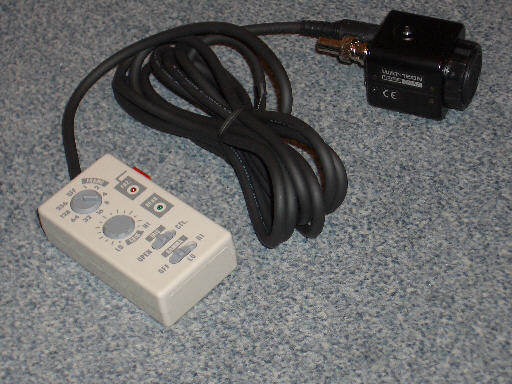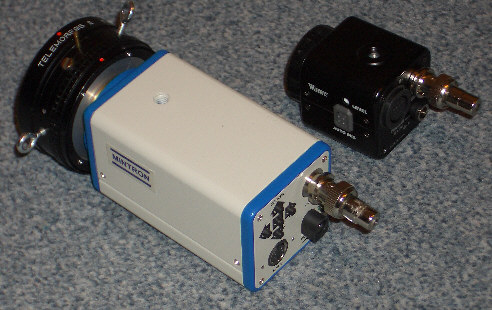|
|
The Watec WAT 120-N can be thought of as the next generation Mintron MTV 12V1C-EX for astrophotography. Well, that is of course not exactly true. Both cameras are made by different companies and they were not developed for astrophotography but as low-light surveillance cameras. However, Watec advertises this camera model especially for astronomical use.
The difference in dimensions reveals how small the Watec is. In spite of its compactness the internal heat generation is not dramatic. The housing is very cold in cold winter nights. Only at air temperatures of well above 10°C the housing will warm a little bit. The number of hot pixels increases slightly with the rise in temperature but the brightness of the background remains very even and dark. Only the upper left corner tends to brighten a little bit after long exposures and with very contrasty images.
The hand controller with its 3 meter long cable is very convenient. The camera can be operated without touching it and causing vibrations of the telescope. By the turning of a knob you can select the number of internally added frames. Up to 256 full frames of 0.04 seconds each total in a maximum exposure time of 10 seconds. Every image is the result of the last 10 seconds or 5 seconds or whatever exposure time was selected. This is different compared to the Mintron which uses a gliding sum of up to 128 half frames.
The CCD sensor of the Watec WAT 120-N has a somewhat different spectral sensitivity compared to the Mintron MTV 12V1C-EX. While the IXC429ALL of the Mintron has a maximum sensitivity at 610 nm and still 50% of the maximum sensitivity in the infrared at 800 nm, the peak sensitivity of the Watec sensor lies more at the blue end of the visual spectrum at around 500 nm. This means that the camera is more sensitive for the blue star clusters in the galaxy arms and that an infrared blocking filter might not be necessary because the sensitivity for infrared wave langths is quite low. I did not test that yet and used always an infrared blocking filter. This filter prevents dust settling on the CCD sensor and that is very important for me. Nevertheless, imaging of galaxies is very easy with the Watec wheras I had the greatest difficulties to image any galaxy with the Mintron. Even M31 showed only its bright core.
I was satisfied with the performance of the Mintron camera, however I am excited with the capability of the Watec camera. I have the impression to reach the same results with the Watec as other astrophotographers with a ST-7 from SBIG as long as it does not come to H-alpha emission objects. I found this true for total exposure times from 10 to 60 minutes. Trials with 60 minutes exposure time did not result in much better (=less noisy) images than exposures of 30 minutes. For practical reasons I stay with 30 minutes total exposure time per object. Sometimes the exposure times are much shorter because of clouds, dew and the dawn.
Technical Data:
Sensor type: SONY ICX-419ALL (HAD type)
Resolution: Physically 795 x 596 pixel, of which 768 x 576 are used according to CCIR/PAL standard
Pixel size: Physically 8,6 x 8,3 µm (Chip size: 6,9 x 5,0 mm)
Sensitivity: Maximum quantum efficiency 50% at about 500 nm, at 800 nm only 30% of maximum sensitivity, from 425-650 nm minimum 80% of maximum sensitivity
Exposure times: 0,04 - 10 s
Amplification: Minimum 8dB, adjustable with potentiometer, cannot be switched off
Gamma: Adjustable in three steps
There is a button to freeze the current image
More information regarding this camera can be found here and here or on the manufacturer's site.

